Don't miss the Alcázar, the Cathedral and the Giralda of Seville!
Visit the magical corners in a spectacular tour with the best guides in the city
Official guide promotion:
62,60€ 54,46€ pax
(Final price INCLUDING TICKETS)

Visit the magical corners in a spectacular tour with the best guides in the city
Official guide promotion:
62,60€ 54,46€ pax
(Final price INCLUDING TICKETS)



Official guide
in English

Priority access
skip the line

Best price
guaranteed
Cancellation and
100% refund
The main entrance to the Alcazar (La Puerta del León) is next to Plaza del Triunfo, on the corner between Miguel de Mañara St. and Santo Tomás St. This gate is flanked by two towers and connected to a wall that belonged to the old Al-Mubarak Palace of Al-Mutamid in the eleventh-century. On the lintel under a corbel, there is a tile mural designed by José Gestoso where a lion is represented in the Gothic style holding a crucifix with a phylactery or band where it can be read in Latin ‘Ad utrumque’ meaning “Ready for everything”.
The lion is considered the king of animals. Since ancient times, the lion has been used as a symbol of strength, power or wisdom, and in cultures such as Egypt, Mesopotamia, China or Japan it was already placed in buildings to drive away evil spirits, in addition to representing the sun and the light from their golden hair and from the belief that they never closed their eyes. The reason why the lion appeared in many European buildings from the Middle Ages is because the royal houses adopted this animal as an emblem of royalty, which is why it is usually represented with a crown.
The door was the old entrance to the palace of Pedro I and apparently it adopted the name of Puerta del León from the nineteenth-century. It was previously known as Puerta de la Montería (Hunting Gate), since it gave access to the Patio de la Montería (Hunting Courtyard). There are several hypotheses of this story, among them, that the name is due to the fact that it was the door used by the kings when they went out hunting. This and other anecdotes will be explained by our guides in depth.
It is accessed through the Patio del León, it is located in the old Sala del Mexuar, where the sura or council of viziers of the old Almohad Palace of Yeso met. This use continued during Christian times.
The Hall of Justice was built in the Mudejar style between 1340 and 1350 by King Alfonso XI. Inside, Heraldic decorations are alternated with Muslim plasterwork and the hall is topped by a spectacular golden dome that closes a space similar to the one of the Sala de Comares in the Alhambra in Granada.
Structurally, it is shaped like a qubba, an Arabic term that identifies a building with a square floor normally closed by a dome. This type of structure passed into Christian architecture through Mudejar art and, although it was used in burials and palatial buildings, it ended up giving rise to the Spanish word alcoba (bedroom).
The Patio del Yeso belongs to the private part of the old Palacio del Yeso (Plaster Palace). It dates from the end of the twelfth-century and is one of the few Almohad constructions that are preserved in the Alcazar. Despite the many reforms of the building throughout history, in the Patio del Yeso, the exoticism of the Al-Andalus buildings are still conserved.
It has a quadrangular floor with mixed and multi-lobed arches, plasterwork decorated with sebka motifs and horseshoe arches in the Caliphate style of Cordoba, but above all it has a central pool that connects, through a canal, with a fountain that is in the Hall of Justice, and where the symbolism of water, that was a fundamental element in Muslim palaces, is exalted because the Koran directly relates water to the creation of life.
El Patio de la Montería. The name is given because it was the place where the kings, in the company of their entourage, organized huntings. It is one of the most beautiful architectural spaces in the Alcazar. It is presided over by the entrance of the Mudejar Palace built by King Pedro, and it is closed by two double-height arcaded galleries, one of them was bricked up in the fifteenth-century.
The other gallery, from where you access to the Admiral’s Room and the Upper Palace, preserves the portico with semicircular arches and a second glazed gallery. The floor was designed by Juan Talavera in 1942 inspired by designs evoking Renaissance squares such as the Campidoglio in Rome.
The front of the Mudéjar Palace is structured as an altarpiece with two bodies and three streets where banked arches are interspersed with multi-lobed ones and where Muslim and Christian elements coexist with schematized plant decorations, sebka cloth, heraldic shields and Kufic inscriptions.
El Patio del Crucero. The courtyard, from the twelfth century, is accessed from the west side of the Hunting Courtyard. Originally, this Almohad courtyard was distributed in the traditional way of Muslim palatine courtyards: the rectangular gardens were built on two levels, the highest one in the current height and the lowest was divided into four gardens with orange trees. It had two galleries in the shape of a cross with a fountain in the center surrounded by other four galleries with two pools, enhancing once again the symbolism of water.
After the damage to the courtyard caused by the Lisbon earthquake in 1755, the lowest garden disappeared and the entire floor was brought to the level of the rooms. The reform was carried out by Sebastián Van der Brocht, who also made the two courtyard doorways in a Baroque style and covered up the side corridors which turned into underground chambers, where the only remaining vestige of the Almohad mark are located, Los Baños de María Padilla (The Baths of María Padilla).
Currently, the courtyard is crossed by two cross-shaped streets with four gardens which are delimited by hedges as a reminiscent of that Muslim space that disappeared in the eighteenth century.
The Casa de Contratación de Indias was a regulatory institution created by the Catholic Monarchs in 1503 by a Royal Decree where its functions were specified: “collect and keep in it …, as many merchandise, … were necessary to provide all the required things to contract in the Indies; to send there everything that was convenient; to receive all the merchandise and other things … had to be sold or sent to sell and contract with other parties where necessary”. This institution was created to regulate trade with the new Spanish colonies, not only commercially, but logistically, scientifically and judicially.
The new building was initially located in The Atarazana and ranged from The Hunting Courtyard to The Hiring Square. In 1717 the institution was transferred to Cádiz, ceasing its trading operations in 1793. In 1964, the urban space was modified and almost all the buildings disappeared, remaining only the Admiral’s Room and the Courtroom. In the Admiral’s Room, currently used for public events, which is accessed from the Patio de la Montería, there are several large canvases painted by artists such as Alfonso Grosso, Virgilio Mattoni or Eusebio Valldeperas, among others, paintings that our guides will discover for you.
Next to the Almiral’s Room, it is placed the Courtroom. This room was transformed in the sixteenth century and it was used as a meeting place for sailors and navigators. The space, from the sixteenth-century too, is covered by a magnificent coffered ceiling with geometric decoration of Arab influence. In the triptych from 1536, presiding over the room, stands out La Virgen de los Navegantes by Alejo Fernández. Sailors used to pray to this Virgin before embarking in their voyages. This piece is, curiously, the first European religious representation in relation to the discovery of the Americas.
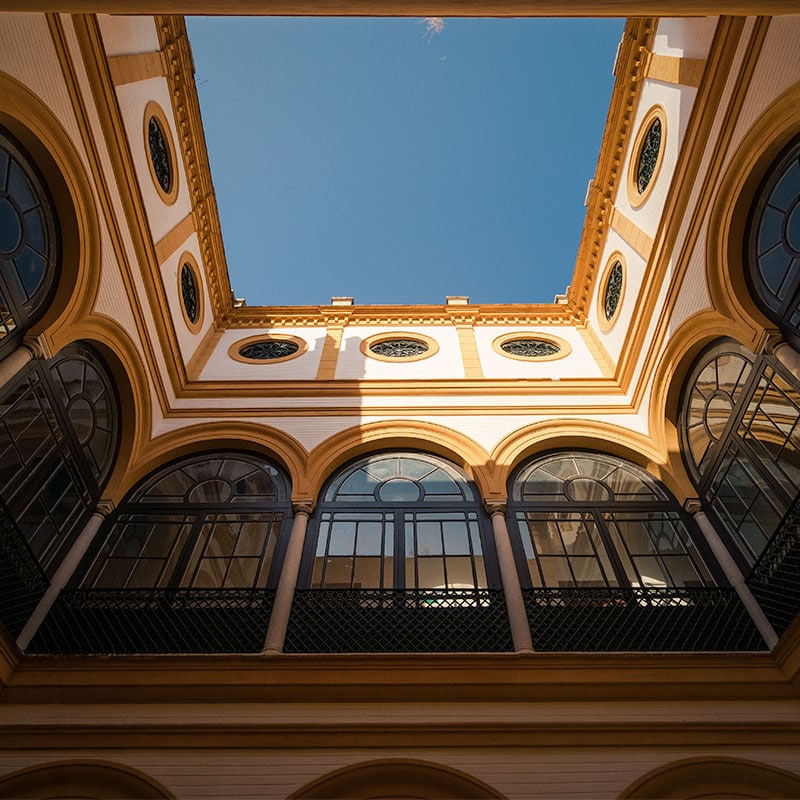
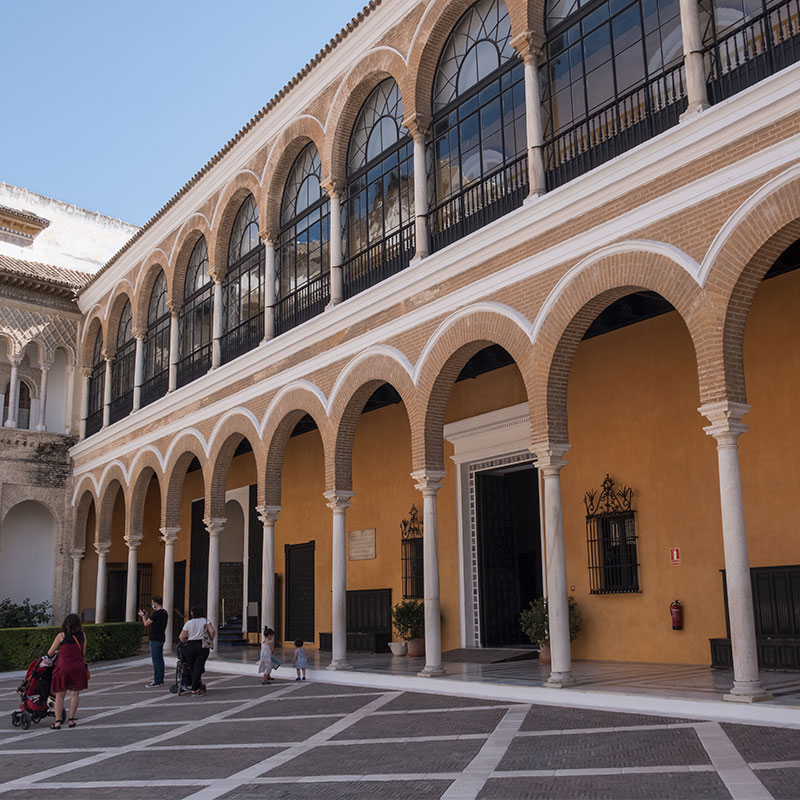

It was built by King Pedro I between 1356 and 1366 in more than 2,500 square meters, and the palace owes its name (Mudejar Palace) to the Mudejar style predominating, both in structure and decoration, in all its rooms. However, it is a new Christian construction over existing Almohad remains, and not an Arab building fitted out for the use of a Christian monarchy. The palace was structured around the Courtyards of the Dolls and the Maidens, courtyards with the intention of differentiating the private life from the public one of the monarch, around which the rest of the palatial rooms were arranged.
Pedro I, who was in love with Seville and the exotic taste of Muslim palaces, established the seat of his court in the Seville capital and planned a great palace to magnify his power. However, the project was not completed because he was assassinated in the Alcazar by his half-brother Enrique II after a civil war that led to the arrival of the Trastamara dynasty to the monarchy. Thus the works of the palace were slowed down until the arrival to power of the Catholic Monarchs, at which time, Seville acquired great strategic relevance for the conquest of the Nasrid Kingdom of Granada.
The Mudejar Palace has undergone important remodeling in courtyards, gardens and buildings. It has been adapted to new tastes and styles as the centuries progressed, such as those carried out by Isabel I, Carlos V or Felipe II. So, countless interesting stories and anecdotes, such as those of the Hiring House or the Hunting Courtyard ones, will be told to the visitors by our guides as they make the tour for the different rooms.
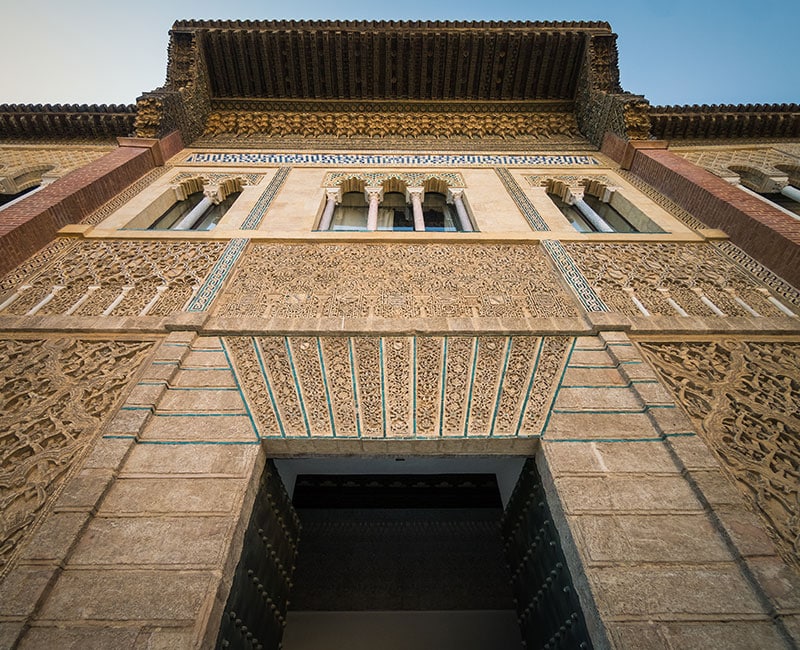
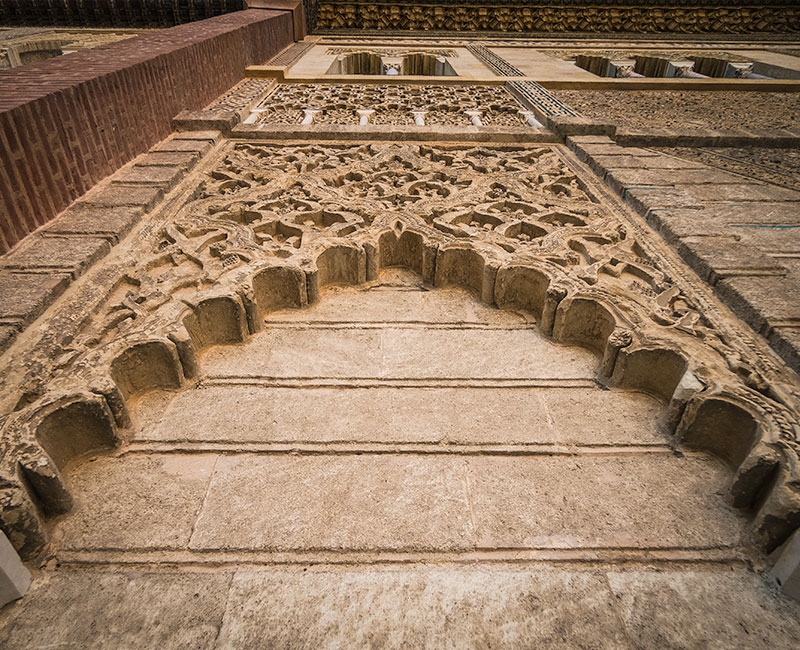

The visit to the Mudejar Palace begins in the Hunting Courtyard. The main portal is an exquisite delight of Andalusian style that rises like a great decorative altarpiece with Arabic and Gothic motifs in a display of elegance and power. In the central body, around a large lintel door, there are different marble columns, multi-lobed arches, mullioned windows, sebka panels and two inscriptions under a large wooden eaves with gilded muqarnas, one in Arabic that says: ” there is no victor but Allah ”, and another with Gothic characters that proclaims:“ the very tall and very noble and very powerful and very conqueror Don Pedro, by the grace of God, the king of Castile and Leon, ordered these fortresses and these palaces to be built in the year 1402”.



Vestíbulo. Behind the frontage, there is a large rectangular hall covered by a magnificent coffered ceiling from where the rest of the palace is distributed. On a tiled plinth is written a phrase in Kufic characters that will be repeated throughout the palace: “Glory to our lord, Sultan Don Pedro, God help him and grant him victory!”
El Cuarto del Príncipe. From the Dolls Courtyard (Patio de las Muñecas), you can access to this room which is divided into three others by plaster decorated arches. The chronicles tell us that in this room the second son of the Catholic Monarchs, Prince Juan de Trastámara, was born in 1478. He was heir to the throne, however the prince prematurely died when he was only 19 years old. Hence the name of this room.
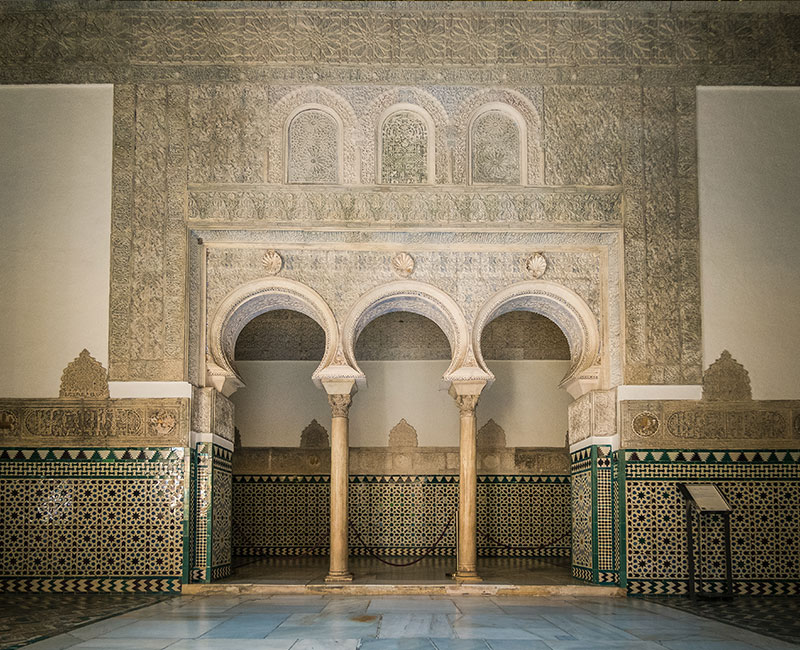

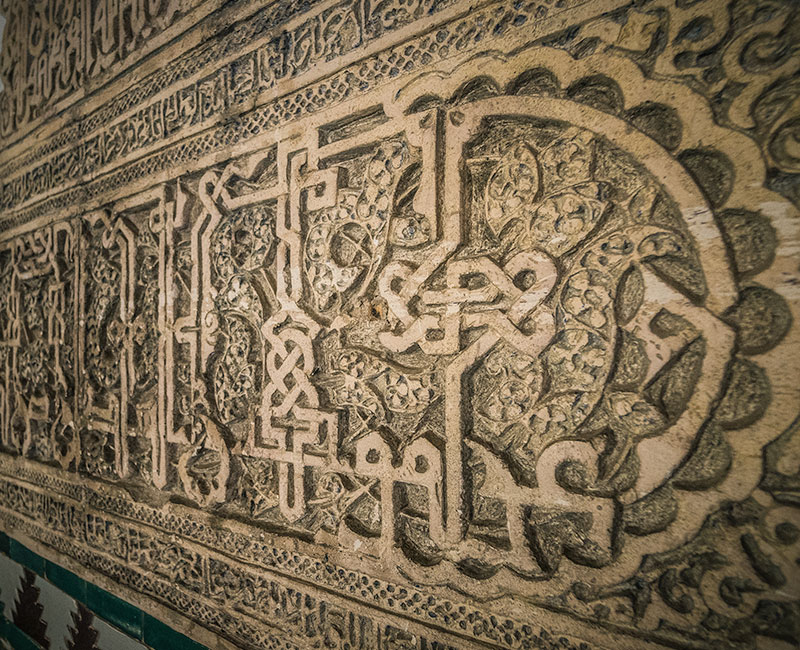
La Alcoba Real, called the Moorish Kings bedroom in times, is divided into two rooms separated by three horseshoe arches which are accessed through another arch flanked by twin windows. The coffered ceilings, the plasterwork friezes and the lace decorated doors stand out.
Salón del Techo de Carlos V. Due to an inscription on Corpus Christi existing in this room, it is believed that it was conceived as an old palace chapel, although the oratory ordered to be built by the Catholic Monarchs caused it to be reused as a private room. The coffered ceiling, from the middle of the sixteenth-century and attributed to Sebastián de Segovia, was installed in the time of Carlos V and is what gives the room its name.
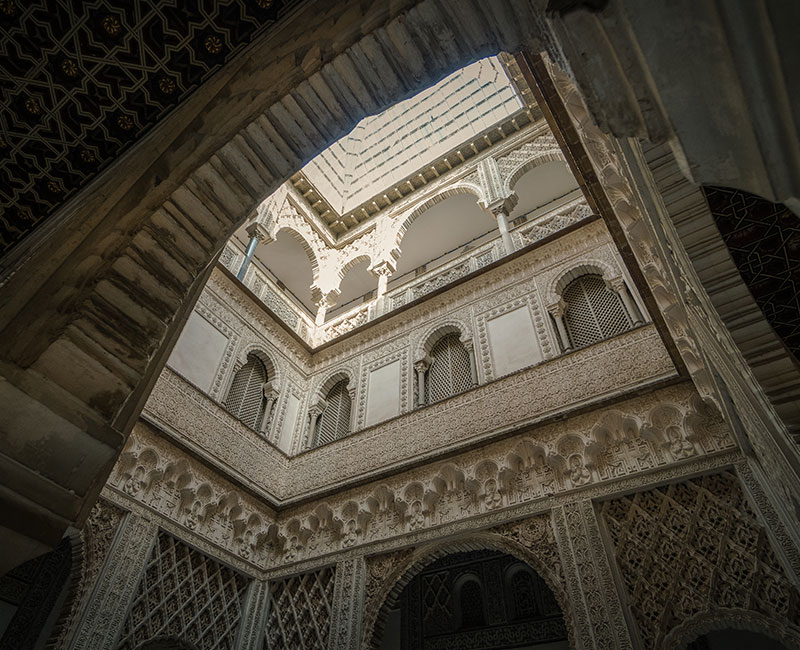
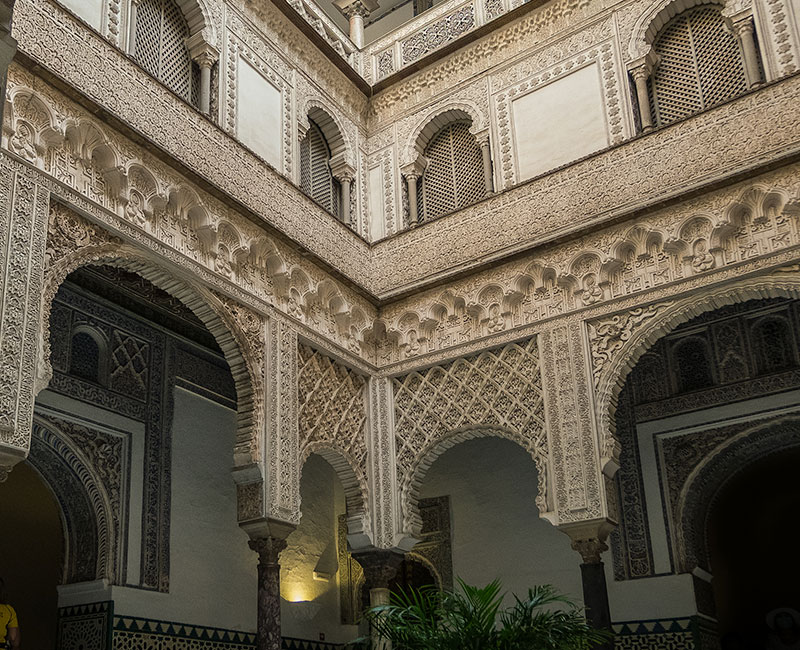
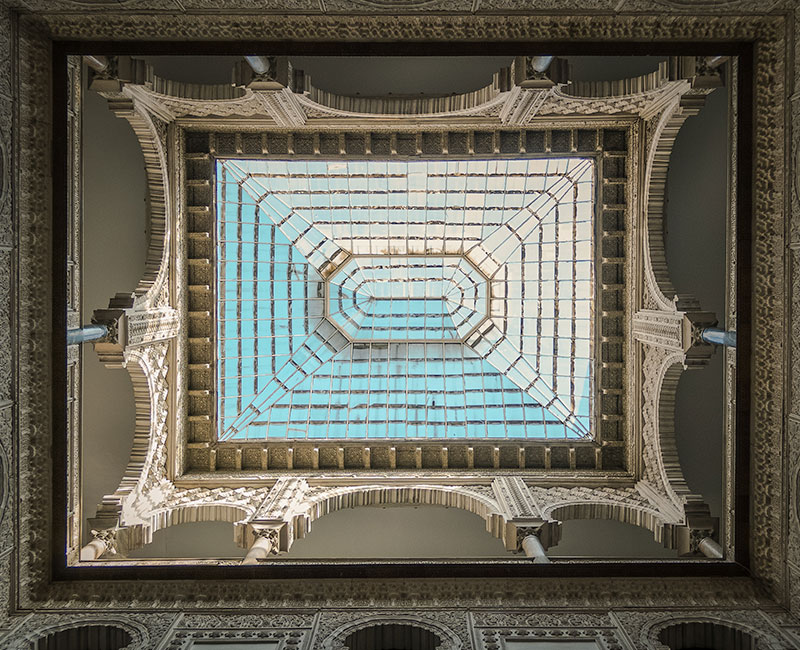
The Patio de las Muñecas is the main courtyard of the private area in the Mudejar Palace, of which the first floor is preserved. In the seventeenth-century, the upper floor was completed, which was modified by Queen Elizabeth II in the middle of the nineteenth-century to adapt it to a royal residence, a function that continues being fulfilled today.
Several hypotheses support this courtyard name. On the one hand, there are experts who think that the name “Dolls” is given because it was the place where infants were raised, while others believe that it is because of its reduced dimensions. However, the most widespread explanation is that the name comes from some small faces reliefs that are sculpted at the arches base and look like children or “dolls”.
The courtyard is a great little jewel of Mudejar art with plasterwork inspired by the Alhambra of Granada based on atauriques, laceries, arabesques and sebka cloth. Despite the anachronism of its elements, columns supporting the galleries arches from Medina Azahara and the upper floor balustrade or the muqarnas cornice from the nineteenth-century, the set maintains the inspiration and exoticism of the Al-Ándalus buildings.
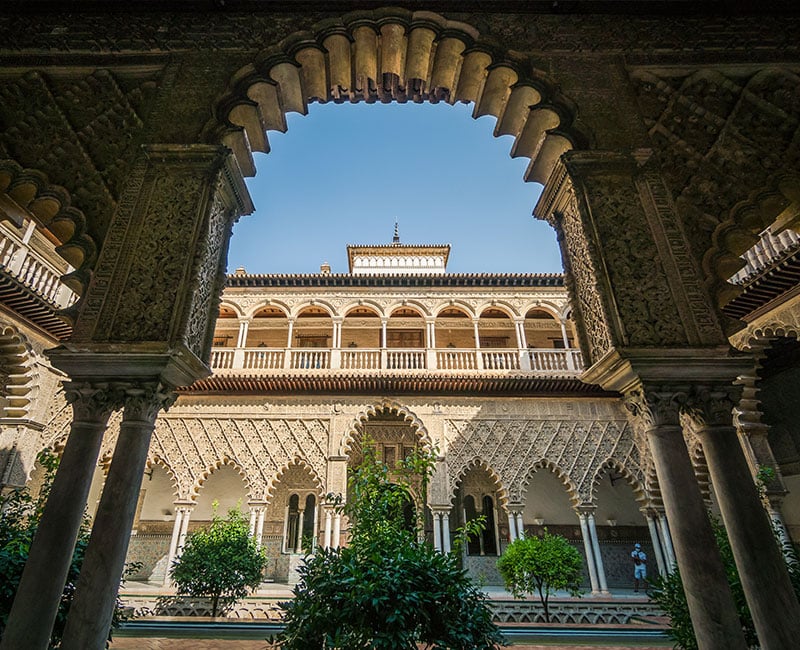
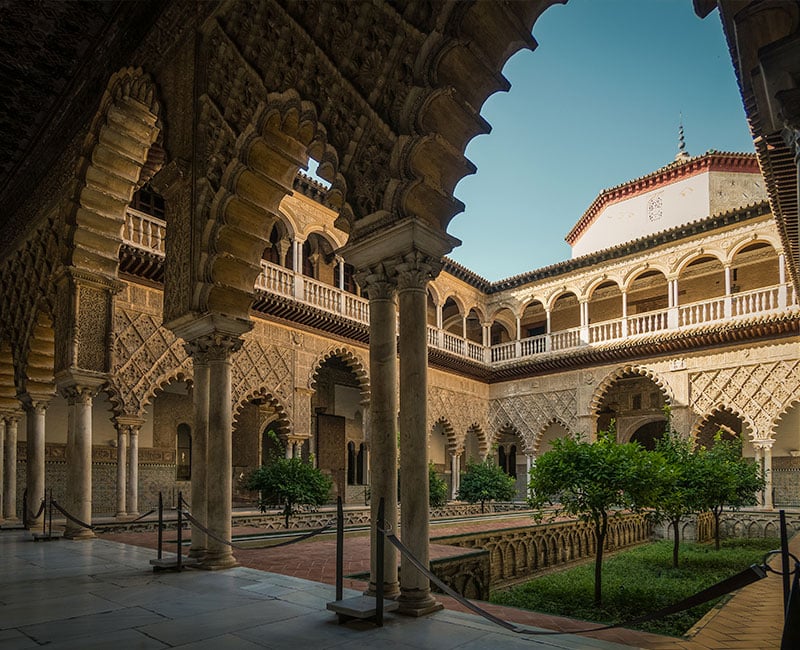
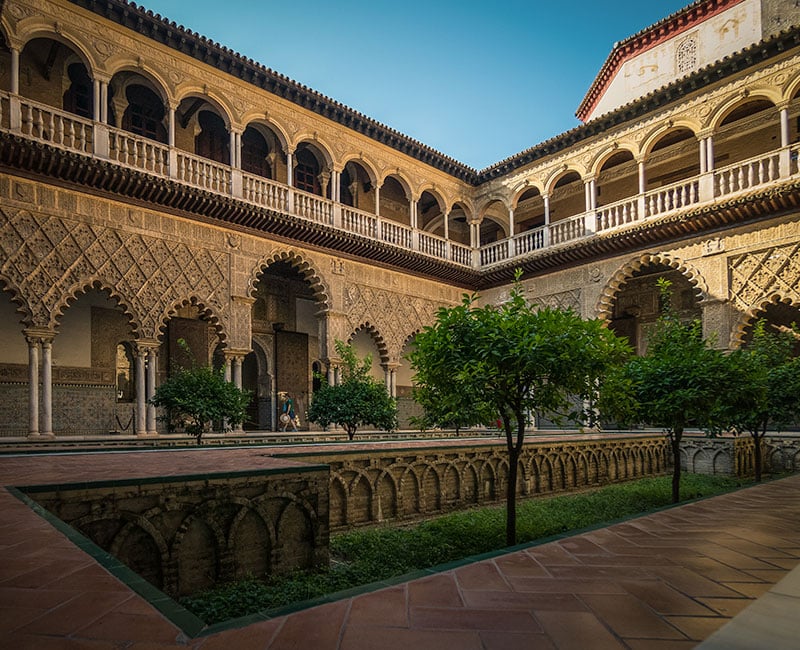

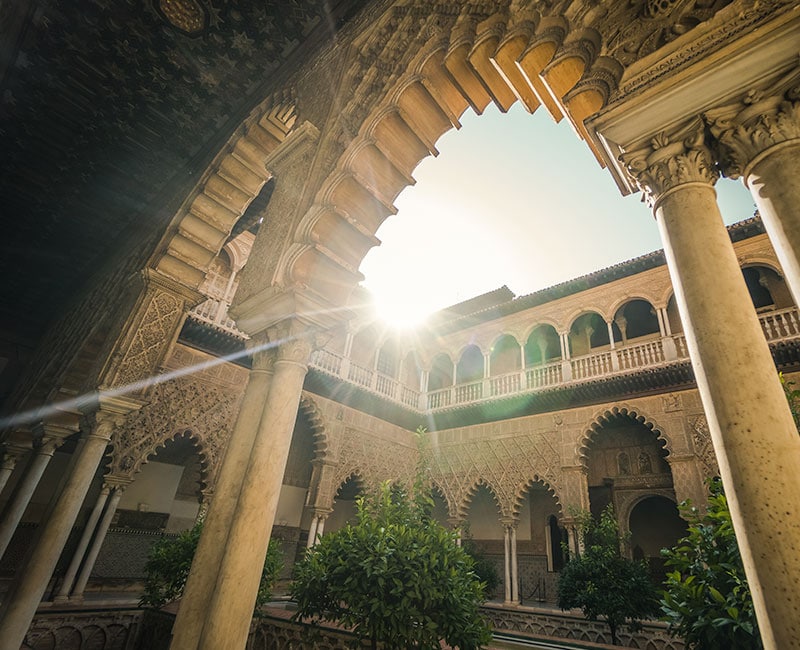
El Patio de las Doncellas. When the visitors enter this courtyard, they experience an aesthetic, high emotional degree sensation: the plasterwork of the lobed arches emanates beauty, the pool establishes a beautiful architectural balance, the flowerbeds transmit serenity, the communication between all the elements is of an exquisite sensitivity and time seems to stop. Undoubtedly, this rectangular courtyard of divine proportions measuring 21 × 15 meters, close to the golden ratio, is one of the great works of the Mudejar art.
It functions as the nucleus that distributes the public area of the Palace, although it has undergone various changes and restructured over the years, such as the semicircular arches on the second floor with a balustrade dating from the reign of Carlos V. Its current structure as a courtyard of a transept of Arab influence, with the pool in the middle and the lower beds, is due to a restoration from the beginning of the twenty – first century where, for example, the interlocking decorative arches found in these beds were recovered.
It is the largest room in the Mudejar Palace and its peculiarity is that it has a coffered ceiling, of half-round Renaissance coffered ceilings, that was installed during the reign of Felipe II giving the room its name.
Another element to highlight, is the Arco de los Pavones, which gives access to the Hall of the Ambassadors. It is formed by a horseshoe arch consisting of three others of the Cordovan caliphate type, and supported by two black marble columns where the decoration of peacocks that gives the room its name appear.
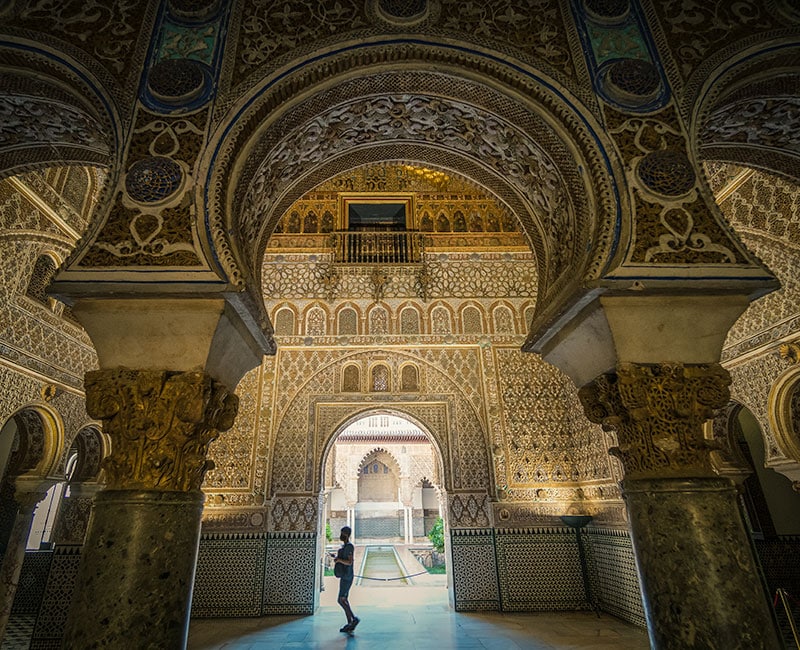
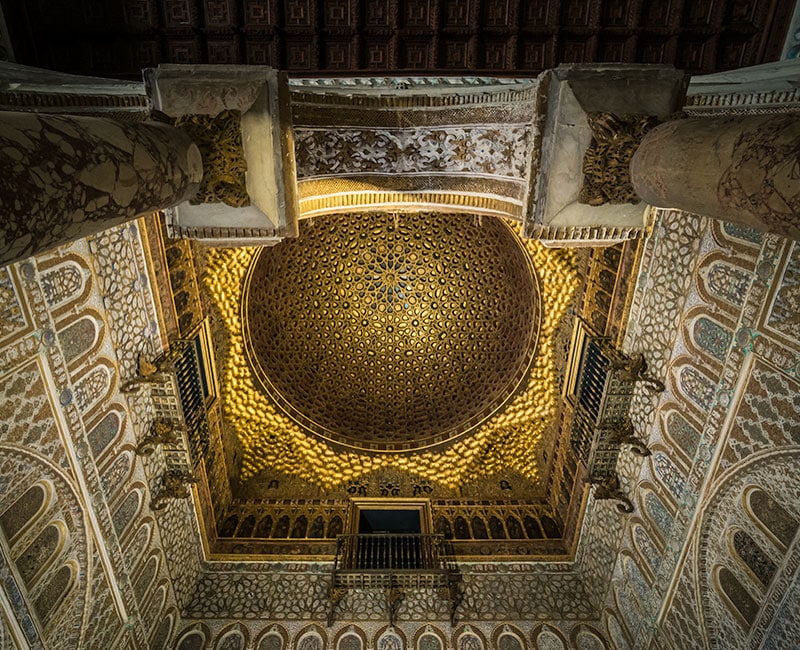
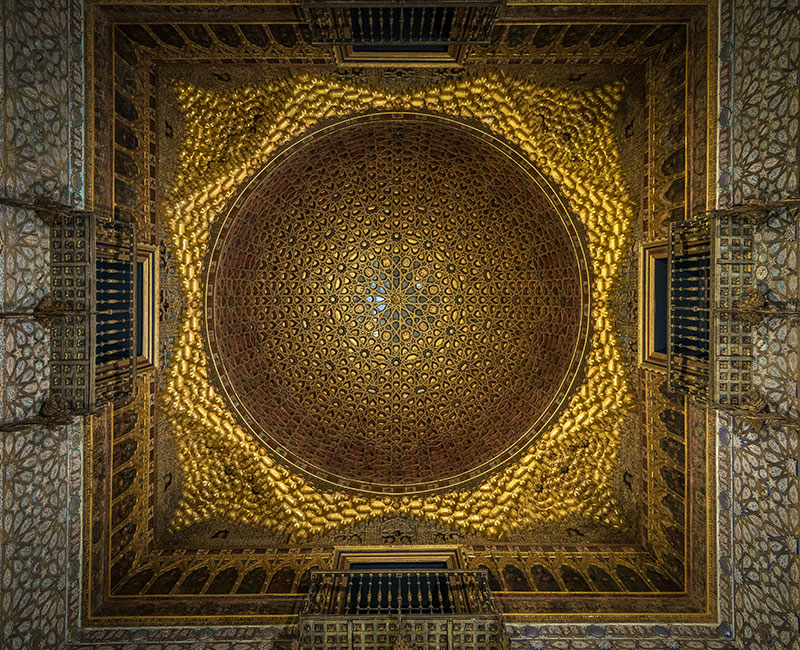
The Salón de los Embajadores is located on the site of the Pleiades Hall of the Al-Mubarak palace in Al-Mutamid. King Pedro I ordered the construction, to the master Diego Ruiz in 1427, of a qubba-shaped building with a square floor and a wonderful hemispherical, also called half orange, dome. As in all the rooms, Arab and Christian motifs are eclectically conjugated on inscriptions in Arabic and phylacteries with evangelical psalms in Latin, wooden balconies, marble columns, horseshoe arches, tiles, plasterwork, atauriques, etc. Visitors may consider interesting too, the late sixteenth – century portraits by Diego Esquivel where the kings up to Felipe III appear in chronological order.
However, the element that stands out the most is the half orange dome, which is to the Mudejar what the Sistine Chapel to the Renaissance. It is a beautiful dome made with a ten lefe loop, considered in carpentry the most perfect lacework layout, of which there are only three others in the world that are located in the Casa de Pilatos (also in Seville), in the Convent of San Francisco de Lima (Peru) and in the National Archaeological Museum (which comes from the Altamira Palace, in Torrijos).
In order for an officer carpenter to obtain the geometric grade, the highest grade in the carpentry trade, a construction with a ten lefe loop was required as the most complex work to be made. The ten lefe loop defines the type of wheels that make up the vault, a type of layout where all the wheels have ten arms and generate a weave that intertwine infinitely, unlike in other developments where bare wheels appear. This waste of power in an architectural state generates a visual sensation of geometric perfection that continues surprising all visitors today.
The Cuarto Real Alto. The so-called Alto Palace is a little gem inside the Alcazar and is currently the official residence of the Kings, Queens and Heads of State when they visit Seville. Built by Pedro I, it has undergone different reforms, among which, those of the Catholic Monarchs and those carried out during the nineteenth-century stand out.
Visitors will be able to enjoy our tours with a high-ranking walk where they can feel how royalty lived and lives in this type of palaces. The tour includes rooms such as the Oratory of the Catholic Monarchs, where the visitation of the Virgin by Niculoso Pisano in 1504 stands out; the dining room, where the miracle of San Francisco Solano and Murillo’s bull are located; Pedro I’s bedroom, the Audiences Room, the Billiard Room and other palatine rooms that make this floor an essential visit.
Palacio Gótico. After the conquest of the Almohad Isbiliya by the Christian hosts in 1248, the Alcazaba was used by the monarchy for its use and enjoyment. In the second half of the thirteenth-century, King Alfonso X El Sabio designed his palace next to the Courtyard of the Transept, on Muslim structures that already existed. The first intervention was in 1254, building conduits to bring water into the Alcazar from the Caños de Carmona aqueduct.
Due to constant renovations, very little remains of the first rectangular Alfonsi palace with castle-like walls and towers, especially due to the structural damage that the building suffered in 1755 after the Lisbon earthquake. Baroque aesthetics took over the palace and all medieval influence almost disappeared, however, the name of the Gothic Palace has endured over time.
It has an entrance through the Courtyard of the Transept through a very theatrical Baroque style frontage, with a porticoed gallery consisting in five semicircular arches supported by pillars that are decorated with double white marble columns made by Sebastián Van der Brocht in the eighteenth-century. The door, of great proportion, has carved decoration with vegetal motifs and two cherubs that support the heraldic shield of the Castilian-Leon crown. Unlike the Mudejar Palace, the Gothic Palace does not have a lobby, so there is a direct access to the Tapestry Room.
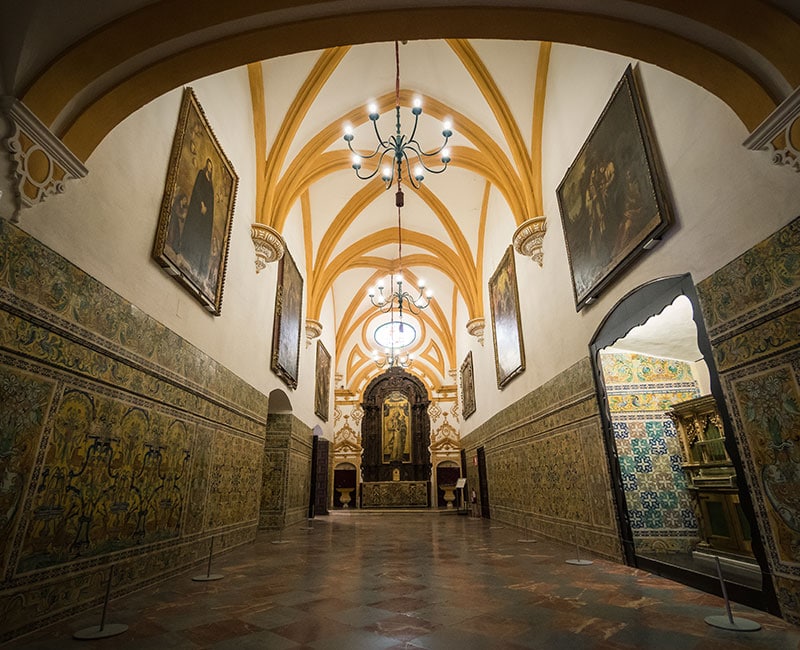
La Capilla del Palacio is an eighteenth-century room where the altarpiece of the Virgen de la Antigua stands out, in baroque style, made in the same century. The painting that presides over the altarpiece is a copy of the original one found in the Cathedral of Seville. Also interesting are the oval stained glass window with the Castilian-Leonese shield, the choir facing the altarpiece, the Renaissance tile plinth, the niches with the organ and the confessional, as well as some large paintings.
Gran Salón. It is also called Sala de las Bóvedas or Sala de Fiestas, because the wedding banquet of King Carlos I and Isabel of Portugal was held here. This space is covered by large ogival vaults supported on corbels and its walls are covered with tiles that were made on the occasion of the aforementioned wedding. Visitors will enjoy beautiful views of the gardens from the windows of the room and the coffered ceiling of the Sala Cantarera, a small adjacent room that is currently reserved for temporary exhibitions.
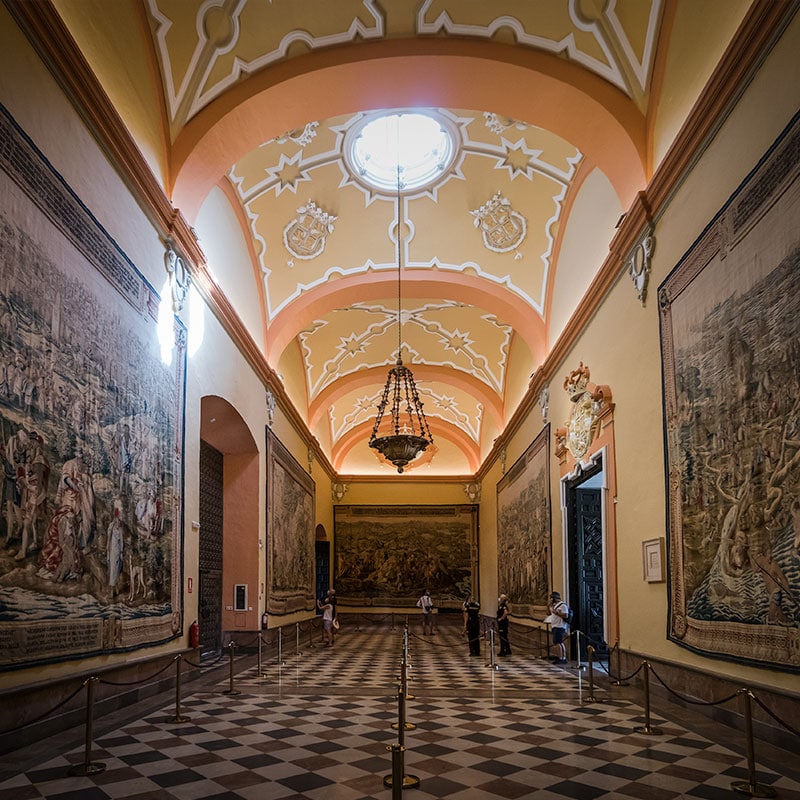
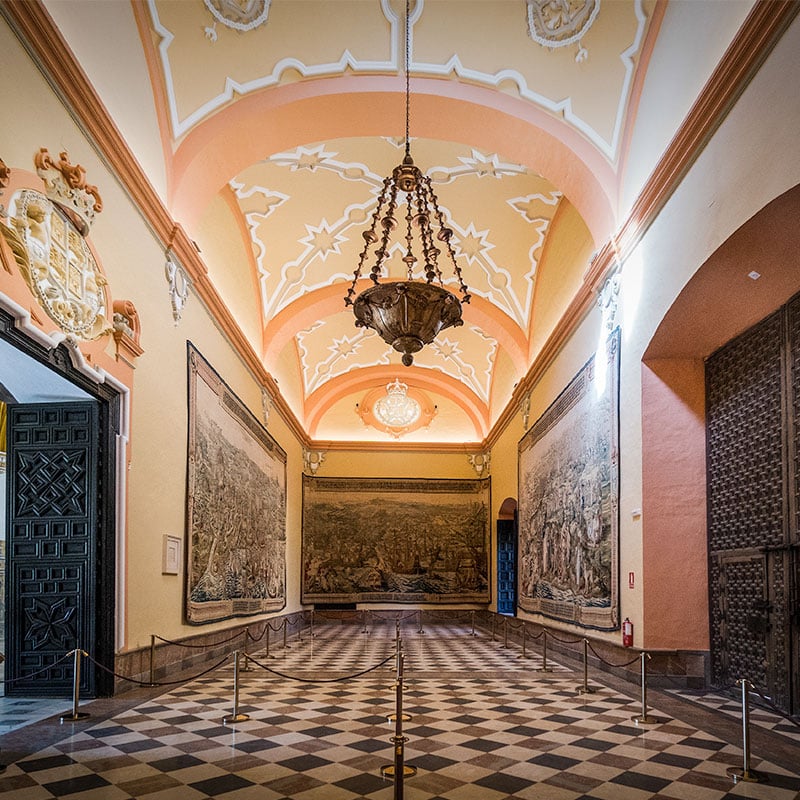

El Salón de los Tapices. This room, which was the first seat of the first Parliament of Andalusia in 1982, stands out for its sobriety and owes its name to the huge tapestries decorating its walls. It was completely rebuilt in the second half of the eighteenth-century due to the damage that occurred in 1755 by the Lisbon earthquake.
The original tapestries, made by Willen Pannemaker’s workshop in Brussels in the middle of the sixteenth-century, represented the Conquest of Tunis by Charles I. Due to wear and tear, ten new tapestries were commissioned in the eighteenth-century, six of which replaced the original, the rest are in Madrid. Our guides will tell the visitor about all the details of these tapestries that are among the best preserved in Europe.
Visit its History, its rooms and its gardens.
With our tour you will discover in detail one of the most beautiful places in the world.
Choose the days and indicate the attendees
The magic of the Cathedral of Seville is waiting for you



Go up and discover the sky of the city of Seville


